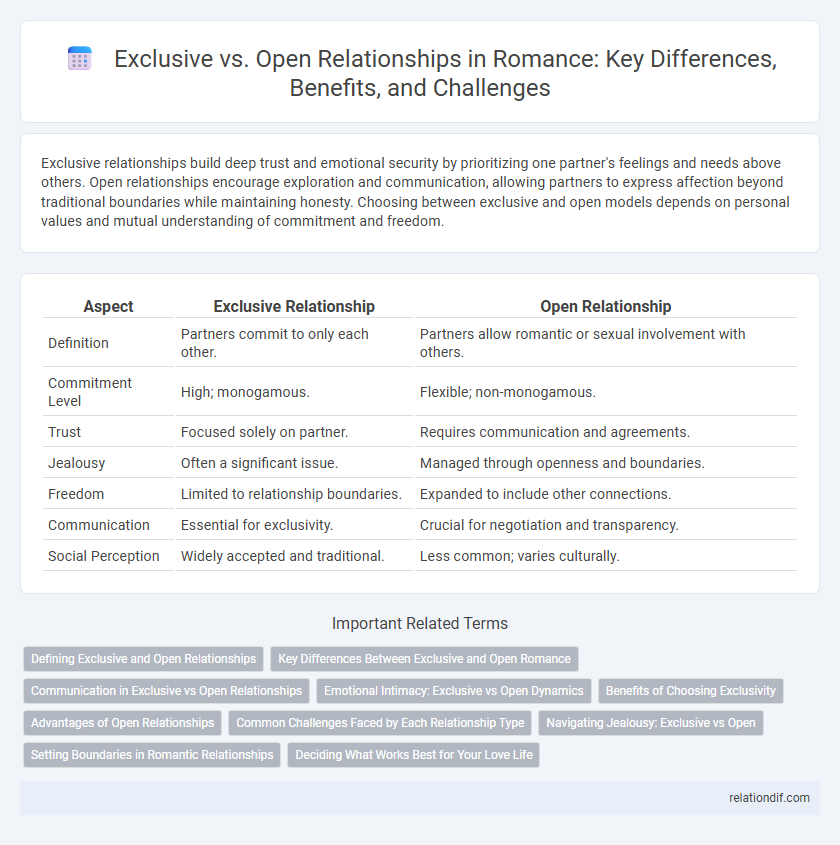Exclusive relationships build deep trust and emotional security by prioritizing one partner's feelings and needs above others. Open relationships encourage exploration and communication, allowing partners to express affection beyond traditional boundaries while maintaining honesty. Choosing between exclusive and open models depends on personal values and mutual understanding of commitment and freedom.
Table of Comparison
| Aspect | Exclusive Relationship | Open Relationship |
|---|---|---|
| Definition | Partners commit to only each other. | Partners allow romantic or sexual involvement with others. |
| Commitment Level | High; monogamous. | Flexible; non-monogamous. |
| Trust | Focused solely on partner. | Requires communication and agreements. |
| Jealousy | Often a significant issue. | Managed through openness and boundaries. |
| Freedom | Limited to relationship boundaries. | Expanded to include other connections. |
| Communication | Essential for exclusivity. | Crucial for negotiation and transparency. |
| Social Perception | Widely accepted and traditional. | Less common; varies culturally. |
Defining Exclusive and Open Relationships
Exclusive relationships involve a mutual agreement where partners commit to emotional and physical intimacy exclusively with each other, fostering trust and deeper connection. Open relationships allow partners to engage in romantic or sexual interactions with others, emphasizing transparency, communication, and negotiated boundaries. Defining these terms clearly helps individuals understand their needs and set expectations to maintain relationship satisfaction and emotional well-being.
Key Differences Between Exclusive and Open Romance
Exclusive romance involves a mutual commitment where partners agree to engage solely with each other, fostering emotional security and trust. Open romance allows partners to explore connections with others, prioritizing autonomy and broader social experiences while maintaining honest communication. Key differences include boundaries on fidelity, levels of emotional intimacy, and the negotiation of relationship expectations.
Communication in Exclusive vs Open Relationships
Effective communication in exclusive relationships often centers on building trust and reinforcing emotional intimacy through consistent, clear dialogues about boundaries and future goals. In open relationships, communication tends to be more complex and frequent, requiring honest discussions about needs, jealousy, and agreements regarding external partners to maintain mutual respect. Both relationship styles benefit from transparency and active listening, which are crucial for addressing insecurities and fostering a secure emotional bond.
Emotional Intimacy: Exclusive vs Open Dynamics
Emotional intimacy in exclusive relationships often fosters deep trust and vulnerability through consistent, focused connection with one partner. In open dynamics, emotional intimacy can be diverse but requires clear communication and boundaries to balance multiple connections without diminishing trust. Studies reveal that exclusive bonds frequently report higher satisfaction in emotional security, whereas open relationships emphasize emotional fluidity and autonomy.
Benefits of Choosing Exclusivity
Choosing exclusivity in a romantic relationship fosters deeper emotional connection and trust, creating a secure environment for vulnerability and growth. Exclusive partners often experience enhanced intimacy and stronger commitment, which can lead to long-term relationship satisfaction and stability. This focused bond minimizes jealousy and misunderstandings, promoting mutual respect and shared values.
Advantages of Open Relationships
Open relationships foster enhanced communication and trust, allowing partners to explore diverse emotional and physical connections without the constraints of exclusivity. They promote personal growth by encouraging independence and self-awareness while reducing pressure and jealousy through transparent boundaries. This relationship style can increase overall satisfaction by fulfilling varied needs and enhancing social support networks.
Common Challenges Faced by Each Relationship Type
Exclusive relationships often face challenges such as maintaining trust and managing expectations around commitment, which can lead to jealousy and communication breakdowns. Open relationships frequently encounter difficulties in setting boundaries and navigating emotional complexities, including feelings of insecurity and balancing multiple connections. Both types require clear communication and emotional honesty to address misunderstandings and foster mutual respect.
Navigating Jealousy: Exclusive vs Open
Navigating jealousy in exclusive versus open relationships requires clear communication and boundary-setting to ensure emotional security. Exclusive relationships often involve heightened expectations of loyalty, which can intensify feelings of jealousy, while open relationships demand mutual trust and transparency to manage insecurities. Understanding each partner's comfort levels and establishing agreed-upon rules helps mitigate jealousy and fosters a healthier romantic connection.
Setting Boundaries in Romantic Relationships
Setting clear boundaries in romantic relationships is essential for maintaining trust and respect between partners. Exclusive relationships often require explicit agreements on fidelity and communication limits, while open relationships emphasize negotiated boundaries around emotional and physical interactions with others. Understanding and respecting these boundaries helps prevent misunderstandings and supports mutual emotional well-being.
Deciding What Works Best for Your Love Life
Choosing between exclusive and open relationships depends on personal values, communication styles, and emotional needs. Exclusive relationships often provide stability and deeper emotional intimacy, while open relationships offer flexibility and exploration. Assessing mutual expectations and boundaries ensures a romantic dynamic that aligns with both partners' happiness and growth.
exclusive vs open Infographic

 relationdif.com
relationdif.com